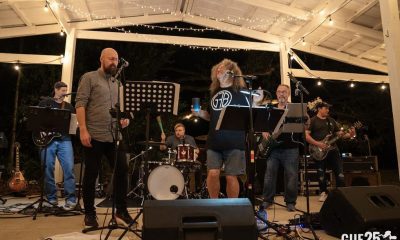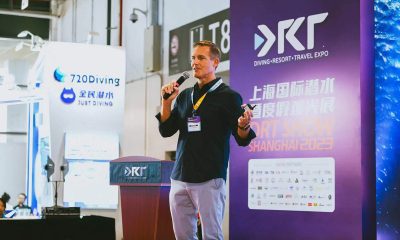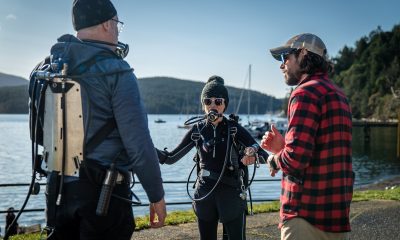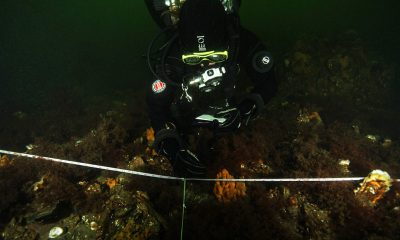Community
Let’s Get to the Core: GUE’s New Project Diver
by Francesco Cameli. Photos from the recent Project Diver core module taught just prior to the GUE conference in High Springs, FL.
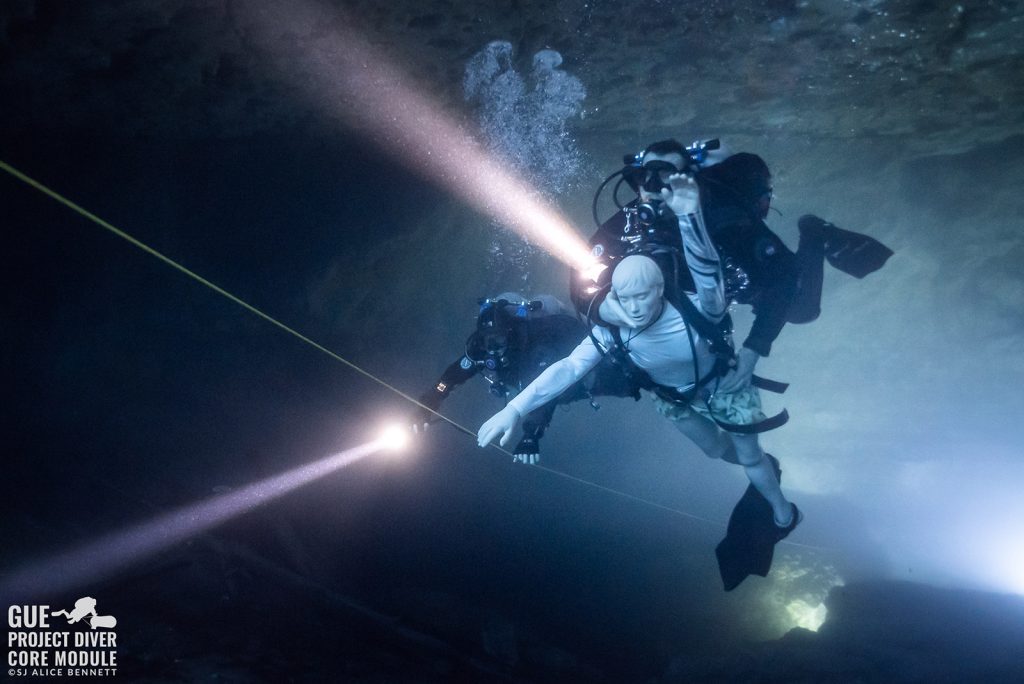
The diving industry is making a shift toward diving with a purpose. Take, for example, the recent Diving Equipment & Marketing Association conference, where the trade show was buzzing with words like “citizen science” and “task-relevant skills sets.” No longer are many of us satisfied with just going for a dive. Of course, diving with a purpose, has been an integral part of Global Underwater Explorers (GUE) DNA from its inception.
This fact was showcased at the annual GUE conference in October, where the organization unveiled a new “Project Diver” program aimed at further engaging divers in exploration and conservation projects around the world.
The two-part course is designed to equip divers not only with the necessary diving skills to complete project dives, but the tools to plan a project from A to Z.
As an instructor for the agency, I was among the first to take the new course.
Becoming a Project Diver
So, what does one need to consider when putting together a project? As it turns out, quite a lot! Let me try to break it all down for you.
GUE’s Project Diver is divided into two main sections: the core module and then a specialized apprentice project in a diver’s chosen field, either cave or ocean. The core module is six days long—four days of presentation and lectures, with two days of in-water skill refinement and related workshops.
Though quite a bit of the discussion topics centred around diving deeper or further into a cave, GUE has removed the deeper or further emphasis from the Project Diver curriculum, electing to instead focus on those separately in advanced diving courses Tech 3 and Cave 3 to be released next year. The idea is the Project Diver program enables divers to get involved in projects sooner in their diving career as there is no need to dive deep into the ocean or into a cave to have a worthwhile and valuable project. Take, for example, the work of Daniel Ortega and David Mulé in The Marine Genome Project. They have been collecting DNA and other samples in the caves in Mexico and Sardinia, and now working in the ocean in Southern California, all within recreational depths. This is a perfect example of a viable scientific project not requiring divers to be tech-trained.
To begin, we need to consider what defines a project and how we identify potential projects. As several speakers pointed out, a project is research or exploration that has a tangible goal and is intended to yield data for further study.
It’s important to identify goals that have exploratory or scientific value, not only to advance our understanding of and ability to protect the aquatic realm, but to convince people to part with their money to help fund said project.

Alberto Nava, a GUE instructor and a National Geographic Explorers grant recipient, was quick to point out the challenges of trying to fund a project. “You see, initially, projects are usually self-funded — and it’s easy to underestimate just how much money is needed. You’ll need to make a detailed list to make sure you cover all the potential expenses and then add a 15% to 20% contingency to be sure. Expenses could include travel, food, accommodation, project specific equipment, gas (the fuel kind), and gas (the breathing kind). The list continues, but you get the point.” A good word of advice from Alberto was to have engaging sales pitches of varying lengths up your sleeve because everyone you talk to could be a potential benefactor for your project. He recommended preparing a 30-second pitch, a 5-minute explanation, and a full length presentation because you never know who you are going to bump into and where.
Risky Business
Okay, you have your idea, you’ve figured out a budget, and you’ve found some money. Now you’re good to go, right?
Wrong.
Enter Brad Beskin, GUE’s Director of Quality Control. Brad is a lawyer (but not GUE’s lawyer, as he is always keen to point out). His discussion was perhaps the most sobering of the whole module.
What is risk? How do we quantify it, and more to the point, how do we isolate ourselves as project leaders from it as much as possible. We all know that diving is not without risk, but with good training, sound judgement, and achievable goals, we can do quite a lot to generally protect ourselves from the physical risk of the diving itself.
When putting together a project, however, that is not enough. A key to insulating yourself from risk as a project leader is to have adequate liability release forms and a comprehensive project manual that covers all of the “what-ifs” in great detail. From simple logistical what-ifs to a detailed emergency procedures document including evacuation, chamber locations, and decisions about whether to have a field medic on the team. The more detailed this document is, the more it may protect you if something bad should happen. It’s important to make sure everyone on the project has had the opportunity to read the document and perhaps even provided a signature to indicate they have read and understand it.
Now can we go diving? Not just yet. There is the not-so-small matter of team selection.
Rich Walker delivered a great presentation on human factors and choosing team members. He introduced the concept of the “no asshole rule” which comes from a good book by Robert Sutton. Team member selection is extremely important, as toxicity spreads very quickly, particularly if the project is tough and requires a lot of lifting and carrying before you even get to dive.
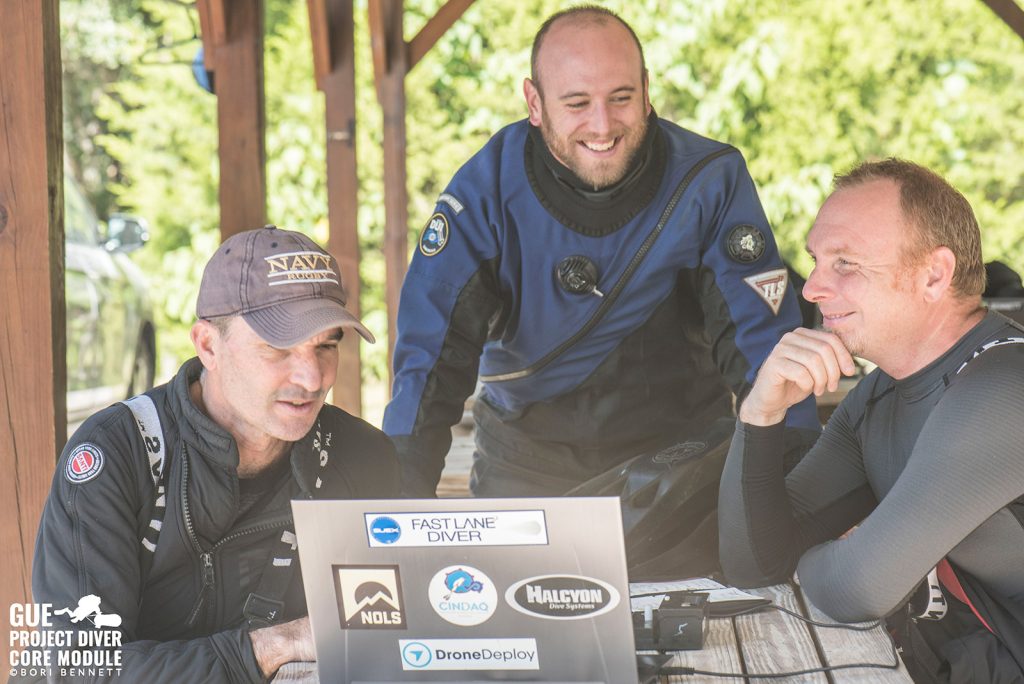
Once all of that is in place, it’s time to dive — however, it’s important to both understand and to have developed the right skills to undertake the project itself. Let us consider some of these and how they were addressed in the core module.
- Photogrammetry
- Decompression
- In-Water Recompression
- Use of Habitats
- Cave survey methods
- Data management
- Sample Collection
- Lifting fragile objects
- Use of rebreathers
- Emergency procedures
Let’s dive in.
Photogrammetry is a simple enough concept: you take a bunch of pictures of an object and then you wait for days or sometimes weeks whilst a computer practically bursts into flames trying to stitch them all together to create a 3D model.
Simple? Not one bit! Thankfully, Photogrammetry Supremos John Kendall and Nava were on hand to enlighten all the core module participants. You see, one needs to understand when, how, and where to use photogrammetry.
As I’m sure you can appreciate, a human skeleton will require a very different technique than a 400ft/120m wreck. Some of it may be possible with divers whilst other projects may require a remote-operated vehicle (ROV). In some cases, one might use still photographs, and in others, you extract frames from video. The combinations and complications are endless because, as simple as it is to do on dry land, once you add water it becomes exponentially a more complex undertaking!
Drawing from their vast experience on the Mars project (discussed below), the Estonia project to map the wreck in the Baltic Sea, or Mexico’s Hoyo Negro and the 13,000-year-old Naia Remains, we were in good hands navigating the subject.
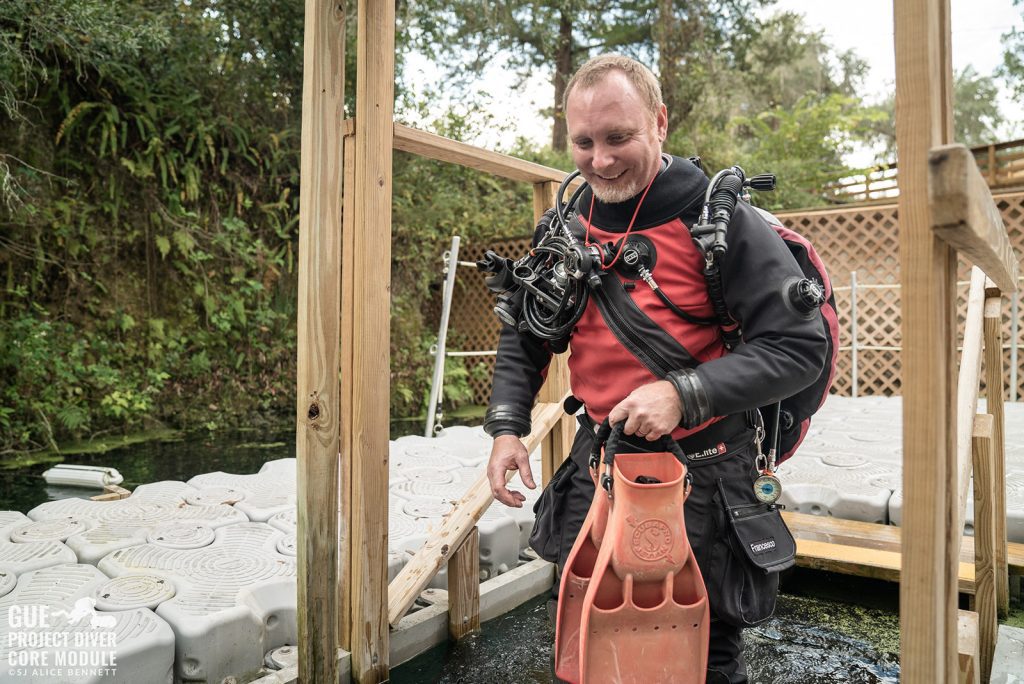
Decompression, and for that matter recompression, all came under the same umbrella and were lectured by David Doolette, a leading expert in underwater medicine and physiology, and introduced in the water by GUE instructor Kirill Egorov.
As projects can take place in sometimes challenging environments, a good understanding of decompression is a must—with an equally good understanding of how to alter your ascent profile as safely as possible whilst taking into account all of the variables that the environment can throw at you.
Take, for example, the “Mars The Magnificent” project in the Baltic sea. The wreck sank in a massive explosion in 1564. It took 20 years to find and has been studied and explored for at least 10 years since its discovery. It sits at 230 ft/69 m of dark, cold water. The bottom is a little warmer than the middle of the water column, which has been nicknamed “the chiller zone” by its explorers. The water temperature at depth is rarely warmer than 4°C/40°F whereas the surface water during can be as warm as 21 °C/70°F. So, with reasonable bottom times, one can expect at least two hours of decompression, and one really does not want to spend too much time at the colder intermediate depths, making it imperative to be able to amend your profile sometimes on the fly based on one’s level of thermal comfort.
This discussion led to research about in-water recompression. Though it has long been an alternate form of emergency treatment in remote areas, it has only been the last few years that in-water recompression has been accepted by the hyperbaric medical community as a viable protocol for tech divers with proper training and preparation.1 This is due to its efficacy, if undertaken rapidly, after the onset of symptoms. However, this too comes with a massive set of logistical, moral, and risk-based complications.
The greatest risk of course being drowning, so it’s largely agreed that to attempt an in-water recompression one must have a good understanding of recompression techniques — and one should only conduct it with a full-face mask. After a big dive, the probability of a hyperoxic seizure increases with exposure to hyperbaric oxygen. Furthermore, it’s imperative to really screen the candidates and assess whether the situation calls for such a drastic course of action. Morally, it should also only be carried out if everyone, particularly the victim, is all in. The discussion then transitioned into which table was most appropriate to use when conducting in-water recompression and, on one of the in-water days, we all spent some time getting familiar with full-face masks and their operation.
Use of habitats. These ingenious structures, simple in design though not in operation, allow divers to make long periods of decompression somewhat more comfortable and less risky. Instead of decompressing fully submerged, divers can pass the time discussing the dive, eating, and generally relaxing as they off-gas. Habitats do have their challenges in that they are tricky to set up, and few companies make them. In fact, most are homemade devices as simple as an inverted plastic tub.
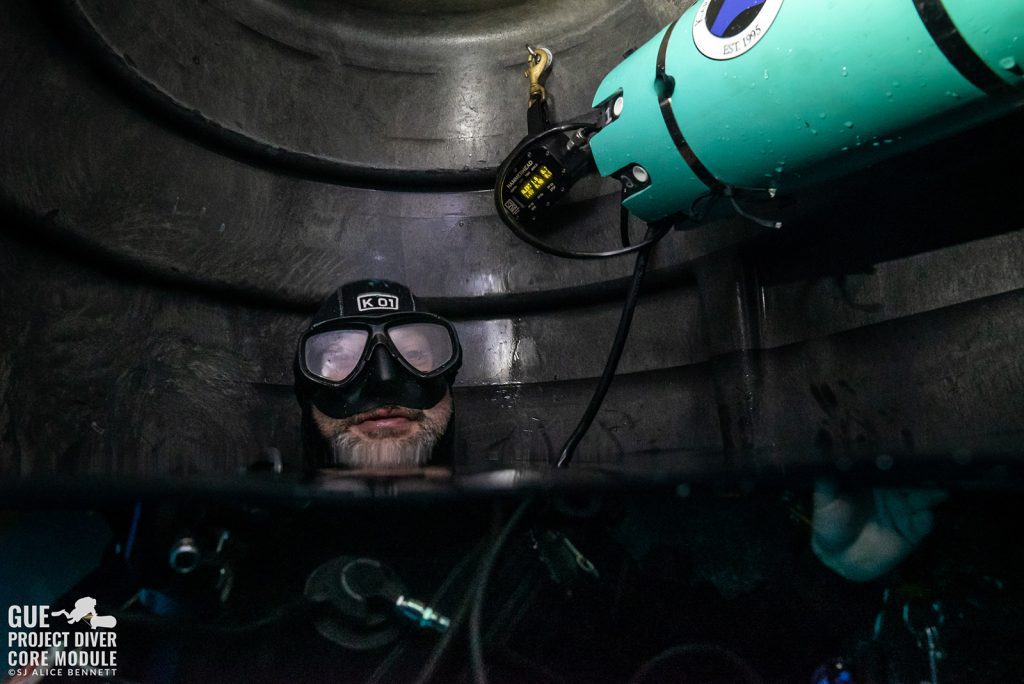
Egorov, the GUE instructor, was on hand to talk us all through the many ways of constructing them and the intricacies of placing them. Habitats are more commonly used in cave diving because the amount of weight required to counteract the buoyancy of that volume of gas proves tricky and unsafe, though not impossible, to deal with in open water. Difficult to maneuver into place, they must be set in a stable part of the cave ceiling at a convenient decompression depth and then filled with gas to effectively pin them to the ceiling. Taking care to ensure that they would never slip, move, or, God forbid, collapse.
As these have become more commonplace in exploration cave diving, some teams go as far as making portable battery-powered scrubber units to clean the internal gas of CO2 and fit oxygen cells to monitor the PO2 in the habitat.
During the in-water sessions, candidates installed a habitat in a cave, filled it with gas, installed the scrubber, and then took it all back out of the cave. A worthwhile exercise, as it really is not all that simple to do.
Cave Survey Methods, Data Management and Sample Collection
As part of a cave project, you may need precise ways to document the cave and or document biological samples you’ve collected. This will likely generate a huge amount of data so almost as important is how this data will be stored, archived, and accessed.
Sam Meacham and Julien Fortin of conservation and education organization CINDAQ were kind enough to come and share with us their ground-breaking work spanning many years of exploration in the Yucatan peninsula and how they have managed to arrange and make accessible terabytes of information.
They also conducted a workshop on common cave survey techniques using an ingenious little unit called an MNEMO. These fussy but simple little pieces of gear allow one to trace a cave line and generate a geographically accurate stick map of the cave which is then used as the backbone on which the rest of the gathered information can be added leading to an eventual accurate survey of any given cave.
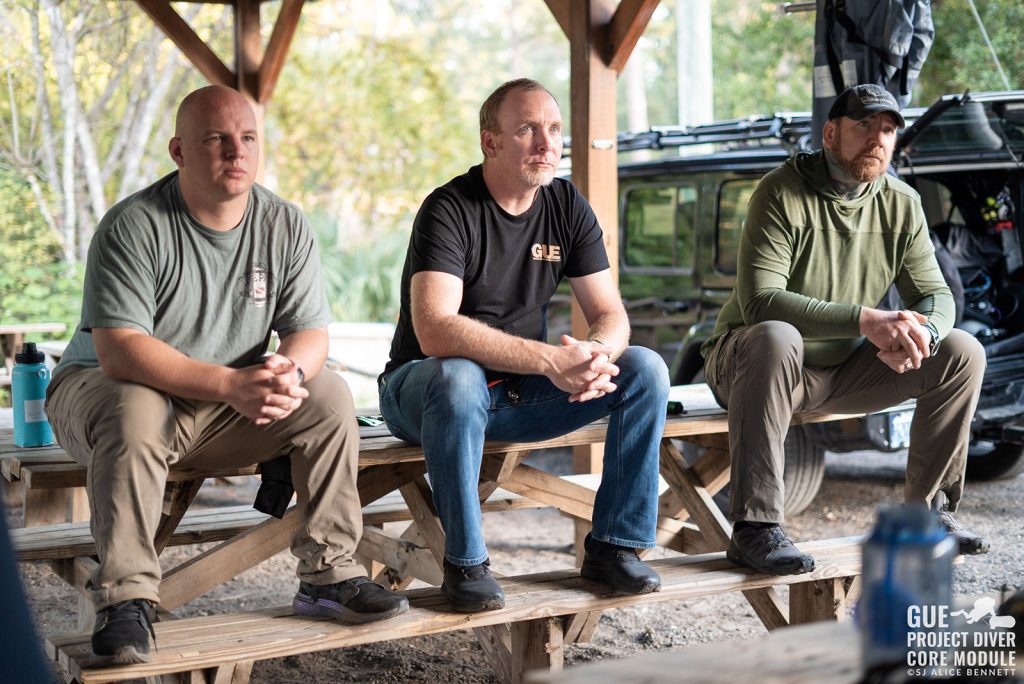
Ortega, the co-founder of the Marine Genome Project, also discussed biological sample collection with examples from his recent trip to the “Map the Gulf Project” headed up by GUE instructor Andrea Marassich, which I was also lucky enough to take part in this year.
What if, on your exploration, you were to stumble across a 13,000-year-old skeleton? Well, Nava, the GUE instructor and National Geographic Explorers Grant recipient, did indeed discover the remains of Naia in Hoyo Negro, so it seemed only fitting that he present to us all how to lift and recover fragile objects of historical and archaeological significance. Part discussion-based, part practical, the task is not as simple as it may seem. Before any kind of lifting or recovery can take place, an accurate record of the site must be made taking the discussion back into the realms of photogrammetry. Then and only then, in conjunction with the appropriate scientist, can decisions be made regarding what, if anything, to recover for further study. In the case of Naia, the entire skeleton was to be retrieved, which was not simple. These 13,000-year-old remains were incredibly fragile, so a suitable way needed to be figured out to recover them safely and intact.
What was learned was that a series of plastic containers with cushioning materials could be used as well as Ziploc bags to place the remains into a lager crate, which would then need to be made neutrally buoyant with a plethora of flotation devices so that the recovery to the surface could be smooth and controlled. Once on the surface, it was imperative to get such remains to the appropriate facility for safe storage. And, for our purposes, depending on the types of objects, this could vary, so it is important to have all of that figured out ahead of time so as not to be left holding the baby so to speak.
Use of rebreathers In our community, at least rebreathers have always been regarded as tools and, as such, only used when the dive at hand required them. Over the years, many types and configurations have surfaced, so it was interesting to go through them all with Egorov, who was able to give detailed explanations of all the various possibilities with all of their advantages and their drawbacks, so that in fact one can choose the right tool for the job.
Finally, no project should be undertaken without an understanding of what to do when things go wrong. Unfortunately, if one is to dive in extreme conditions or locations, the possibility of an accident is ever-present, and so good preparation as a project diver is a definite must. Who better to guide the candidates through oxygen use and CPR than firefighter, EMT, and GUE cave instructor Doug Mudry.
Over a couple of sessions on land and in the water, the candidates were put through their paces, ultimately having to extract a victim from inside an overhead environment before surfacing and moving the victim to a dock where CPR and oxygen administration could more easily take place.
This too is a skill that needs constant practice. I can tell you that even though the victim was a CPR dummy in full scuba gear, one’s pulse and stress levels were somewhat elevated during this exercise.ut, when it’s real, calm must prevail in order to give the victim the best possible chance of survival.
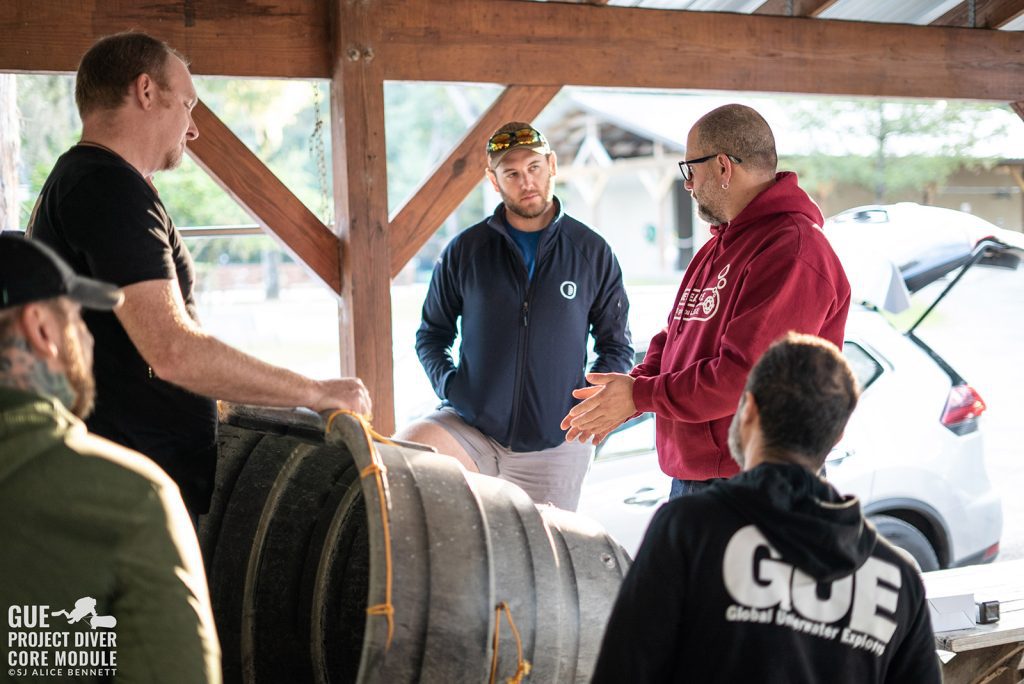
Six days rounded off by in-field maintenance of drysuits, rebreathers, DPVs and regulators, as well as lectures about naval archaeology, remote medicine, and real time physiological diver monitoring brought the core module to an end and, I must say, left everyone with much to think about and chomping at the bit to get stuck into the apprentice projects already planned for 2023.
It is my hope that in the future, generations of divers will take part in the ongoing battle to save our oceans and, in doing so, allow us all to live in harmony with this planet of ours that to date we as a species have been so good at destroying.
Footnote:
- Doolette Dj, Mitchell SJ. In-water recompression. Diving Hyperb Med. 2018 Jun 30;48(2):84-95. doi: 10.28920/dhm48.2.84-95.
See companion story: Building Community Through Project Diving by Guy Shockey
Dive Deeper
InDEPTH: Global Underwater Explorers (GUE) Launches a Comprehensive Project Diver Program in 2022
Fourth Element blog: Re-Envisioning Jacques Cousteau by Michael Menduno

Francesco is Italian but was born in Nice and grew up between London and his hometown of Genova. He speaks four languages and currently resides in Los Angeles, California. Francesco spent his childhood summers freediving in Portofino where he developed his love of the sea. The work of Jaques Cousteau and Luc Besson’s film The Big Blue were responsible for his desire to become a marine biologist. As things would turn out, however, he followed a career in music where he has become a successful recording engineer and owner of two world class recording studios. Once he tried scuba, Francesco was hooked from his first dive. He is now an avid tech and cave diver as well as a budding underwater photographer. As a GUE instructor, Francesco’s passion for diving and the ocean is infectious. He currently teaches the recreational and fundamental curriculum as well as technical diver 1 in various countries including the USA, Italy and Mexico. He has taken part in projects including: Reef Alert Network (Portofino Italy), Project Baseline (Orange County USA) and Map the Gulf (Sardinia Italy). He has contributed to the TV show Expedition Unknown as an exploration tech diver, cameraman, and 3D Photogrammetry diver.






















